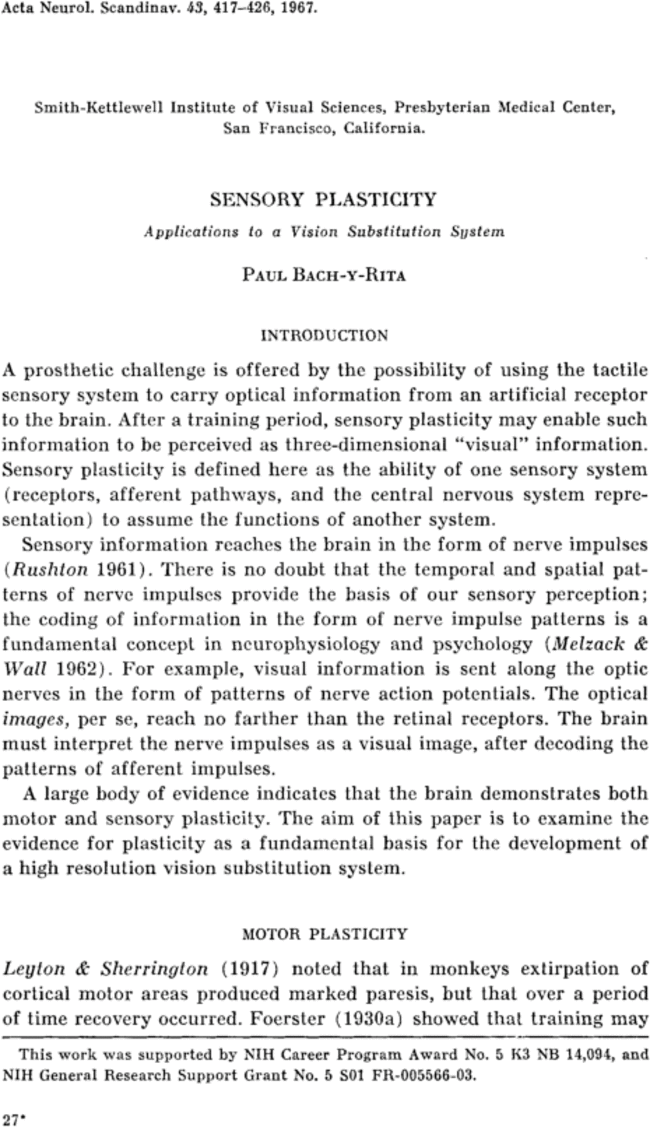Full Access
SENSORY PLASTICITY
Applications to a Vision Substitution System
Paul Bach-y-Rita,
Corresponding Author
Paul Bach-y-Rita
Smith-Kettlewell Institute of Visual Sciences, Presbyterian Medical Center, San Francisco, California.
Paul Bach-y-Rita, M.D., Smith-Kettlewell Institute of Visual Sciences, Presbyterian Medical Center, San Francisco, California.Search for more papers by this authorPaul Bach-y-Rita,
Corresponding Author
Paul Bach-y-Rita
Smith-Kettlewell Institute of Visual Sciences, Presbyterian Medical Center, San Francisco, California.
Paul Bach-y-Rita, M.D., Smith-Kettlewell Institute of Visual Sciences, Presbyterian Medical Center, San Francisco, California.Search for more papers by this authorThis work was supported by NIH Career Program Award No. 5 K3 NB 14,094, and NIH General Research Support Grant No. 5 S01 FR-005566–03.

REFERENCES
- Adrian, E. D. (1949): Sensory integration. The Sherrington Lectures. University Press, Liverpool.
- Bach-y-Rita, P. (1964): Conevrgent and long latency unit responses in the reticular formation of the cat. Exp. Neurol. 9, 327–344.
- Bliss, J. (1962): Kinesthetic-tactile communications. I.R.E. Trans. 1-T8, 92–99.
- Bliss, J. (1967): Tactile perception: experiments and models. NASA Contr. Rep. CR 623, Washington, D.C.
- Collins, C. C. (1967): Tactile image projection. J. Soc. Information Display (in press).
- Collins, C. C., R. Acker, G. Holmlund & P. Bach-y-Rita: A video tactile image projector (in preparation).
- Fessard, A. (1961): Sensory communication. W. H. Rosenblith ed. John Wiley and Sons, New York, pp. 585–606.
-
Foerster, O. (1930a): Restitution der Motelität.
Dtsch. Z. Nervenheilk.
115, 248–295.
10.1007/BF01668632 Google Scholar
- Foerster, O. (1930b): Restitution der sensibilität. Ibid. 296–314.
- Gardener, K.: An optical to tactile image converter. Proc. of the St. Dunstan's International Conference on Sensory Devices for the Blind, London, (in press).
- Geldard, F. (1960): Some neglected possibilities of communication. Science 135, 1583–1588.
- Gellhorn, E. (1953): Physiological foundations of neurology and psychiatry. University of Minnesota Press, Minneapolis.
- Gilmer, B. v. H. (1966): Problems in cutaneous communication from psychophysics to information processing. Amer. Foundation for the Blind, New York.
- Hawkes, G. R. (1960): Cutaneous sensitivity. U.S. Army Med. Res. Lab. Rep. No. 424, Washington, D.C.
-
Head, H. (1918): Sensation in the cerebral cortex.
Brain
41, 57–253.
10.1093/brain/41.2.57 Google Scholar
- Howell, W. C. (1960): On the potential of tactual displays: an interpretation of recent findings. Symposium on cutaneous sensitivity. G. Hawkes, ed. U.S. Army Med. Res. Lab. Rep. No. 424, Washington, D.C., pp. 103–113.
-
Kotovsky, K., &
J. Bliss (1963): Tactile presentation of visual information.
IEEE Trans. Mil.
7, 108–113.
10.1109/TME.1963.4323059 Google Scholar
- Lashley, K. S. (1952): Functional interpretation of anatomic patterns. Res. Publ. Nerv. Ment. Dis. 30, 529–547.
- Leyton, A. S., & C. S. Sherrington (1917): Observations on the excitable cortex of the chimpanzee, orangutan and gorilla. Quart. J. exp. Physiol. 11, 135–222.
- Livingston, R. B. (1959): Central control of receptors and sensory transmission systems. Handbook of physiology, J. Field, ed. Amer. Physiol. Soc., Washington, D.F. Vol. 1, pp. 741–760.
- Melzak, R., & P. D. Wall (1962): On the nature of cutaneous sensory mechanisms. Brain 85, 331–356.
- Morris, A., C. C. Collins & P. Bach-y-Rita: Factors influencing cutaneous perception studied with a tactile display system (in preparation).
- Mountcastle, V. B. (1961): Duality of function in the somatic afferent system. Brain and behavior. M. A. B. Brazier, ed. Amer. Inst. Biol. Sci., Washington, D.C., Vol. 1, pp. 67–93.
- Murata, K., H. Cramer & P. Bach-y-Rita (1965): Neuronal convergence of noxious, acoustic and visual stimuli in the visual cortex of the cat. J. Neurophysiol. 28, 1223–1240.
- Paskik, P., & Pasik, T. (1964): Oculomotor functions in monkeys with lesions of the cerebrum and the superior colliculi. The oculomotor system. M. Bender, ed. Harper and Row, New York, pp. 40–80.
-
Penfield, W., &
H. H. Jasper (1954): Epilepsy and the functional anatomy of the human brain. Little, Brown and Co., Boston.
10.1097/00007611-195407000-00024 Google Scholar
- Rushton, W. A. H. (1961): Peripheral coding in the nervous system. Sensory communication. W. A. Rosenblith, ed. John Wiley and Sons, New York, pp. 169–181.
- Sholl, D. A. (1956): The organization of the cerebral cortex. J. Wiley & Sons, New York.
- Smith, A., & C. W. Burklund (1966): Dominant hemispherectomy: preliminary report on neuropsychological sequelae. Science 153, 1280–1282.
- Starkiewicz, W., & T. Kuliszewski (1965): Progress report on the elektroftalm mobility aid. Proc. Rotterdam Mobility Research Conference. Amer. Foundation for the Blind, New York, pp. 27–38.
- Uttal, W. R., & L. Cook (1964): Systematics of the evoked somatosensory cortical potential: a psychophysical electrophysiological comparison. Sensory evoked response in man. H. Whipple, ed. Annals of the N. Y. Acad. of Sci., Vol. 112, pp. 60–80.
- Weddell, G. (1961): Receptors for somatic sensation. Brain and Behavior. M. A. B. Brazier, ed. Amer. Inst. Biol. Sci. Washington, D.C., Vol. 1, pp. 13–48.
-
Weiss, P., &
P. Brown (1941): Electromyographic studies on recoordination of leg movements in poliomyelitis patients with transposed tendons.
Proc. Soc. Exper. Biol.
48, 284–287.
10.3181/00379727-48-13298P Google Scholar




